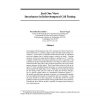Free Online Productivity Tools
i2Speak
i2Symbol
i2OCR
iTex2Img
iWeb2Print
iWeb2Shot
i2Type
iPdf2Split
iPdf2Merge
i2Bopomofo
i2Arabic
i2Style
i2Image
i2PDF
iLatex2Rtf
Sci2ools
NIPS
1997
1997
Just One View: Invariances in Inferotemporal Cell Tuning
In macaque inferotemporal cortex (IT), neurons have been found to respond selectively to complex shapes while showing broad tuning (“invariance”) with respect to stimulus transformations such as translation and scale changes and a limited tuning to rotation in depth. Training monkeys with novel, paperclip-like objects, Logothetis et al.9 could investigate whether these invariance properties are due to experience with exhaustively many transformedinstances of an objector ifthere are mechanisms that allow the cells to show response invariance also to previously unseen instances of that object. They found object-selective cells in anterior IT which exhibited limited invariance to various transformations after training with single object views. While previous models accounted for the tuning of the cells for rotations in depth and for their selectivity to a specific object relative to a population of distractor objects,14,1 the model described here attempts to explain in a biologicall...
| Added | 01 Nov 2010 |
| Updated | 01 Nov 2010 |
| Type | Conference |
| Year | 1997 |
| Where | NIPS |
| Authors | Maximilian Riesenhuber, Tomaso Poggio |
Comments (0)

